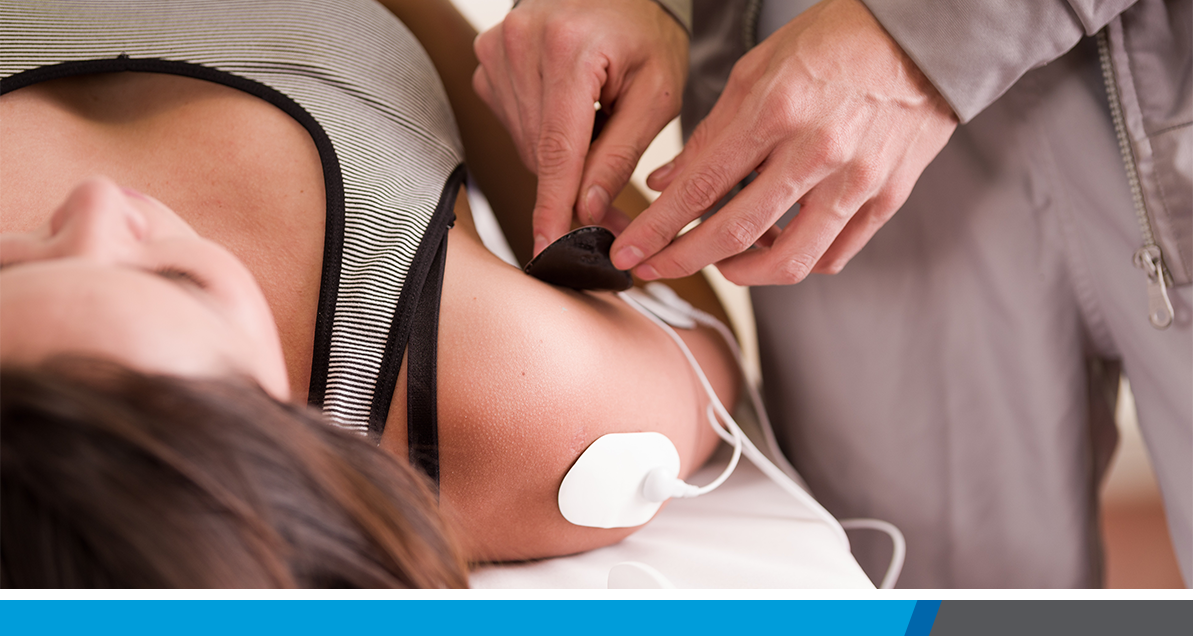
Three Common Electrotherapy Mistakes that Lead to Infection
Electric stimulation, or electrotherapy as it’s commonly referred to, is useful for patients in physical therapy. It can help with low back pain, surgical pain, muscle weakness, poor motor control, tendinitis and bursitis.
However, as useful as it is for patients, sometimes it can worsen their conditions if proper precautions aren’t taken. To keep your patients safe, you need to be aware of how you could be putting them at risk. Here are three common electrotherapy mistakes that lead to infection.
Electrodes are used repeatedly on the same patient during electrotherapy sessions and then sealed in a patient file with other patients’ electrodes.
If electrodes are only used on the same patient, everything is fine, right? Wrong.
Dead skin, residual debris, and contaminants from the patient cling to electrodes during use. Research from the American Journal of Infection Control has shown that 25 percent of cleaned reusable electrodes had bacteria present. Of the bacteria types identified, seven out of eight carried risk for infection.
This is especially dangerous in physical therapy settings where harmful bacteria can thrive due to the conditions. A study published in Physiotherapy examined physical therapy classrooms and found bacteria growth in 53 percent of environmental samples from various surfaces. The bacteria identified included S. Aureus (MRSA), S. hominis, S. epidermidis, Micrococcus luteus, Kocuria kristinae, and various gram positive bacilli.
The study noted that the environment presented opportunities for the bacteria to grow and spread because of the skin-to-skin contact between people and contact with equipment.
So, each time a standard electrode is used, there’s a risk of it picking up bacteria and spreading that bacteria once it’s filed with other electrodes. These conditions are perfect for infection.
However, one small change can keep electrotherapy patients safe from infection. Switching to an antimicrobial electrode, such as the MicroBlock can protect patients. The MicroBlock is designed to prevent infection by killing and inhibiting the growth of bacteria on and even around the electrode, in the area known as the zone of inhibition. Independent testing shows that it’s more than 99 percent effective in reducing several forms of harmful bacteria:
E. Cloacae (CRE)
S. Aureus (MRSA)
E. Coli (ESBL)
E. Faecalis (VRE)
P. Aeruginosa and A. Baumannii (Multidrug Resistant)
By using a product like this, physical therapists can keep patients free from infection during electrotherapy sessions.
However, physical therapists need to be aware of more than just electrodes.
Order A Free MicroBlock Sample Today!
Reusing Lead Wires
Like most electrodes, lead wires are regularly reused in electrotherapy. There’s often a cleaning protocol for the lead wires, but multiple lead wires tend to tangle. This makes it difficult to clean them effectively, which means they’re a vehicle for bacteria.
The numbers vary, but multiple studies have found that cleaned, reusable lead wires carry bacteria. Research on reusable lead wires identified bacteria growth in 63 percent of samples, with 38 percent containing potential-risk bacteria.
Another study found that 51 percent of manually cleaned electrode lead wires were contaminated with bacteria or risk pathogens. A third study found that 77 percent of “clean” lead wires were contaminated with antibiotic-resistant bacteria.
It’s safe to say that reusing lead wire—even after being cleaned—is another way bacteria can spread between patients, putting them at risk for infection.
Physical therapists can protect patients by using MicroBlock antimicrobial electrodes, which kill bacteria. This decreases the likelihood it will make its way to the lead wires where it can propagate. Alternatively, disposable lead wire sets can be used, eliminating ineffective cleaning between uses.
Neglecting Proper Hygienic Practices
Electrotherapy often takes place in outpatient settings, where there may be less focus on hygienic infection prevention practices. There might not be standard cleaning procedures in place or they are poorly executed.
As the World Health Organization notes: “The culture of infection prevention and control, including hand hygiene, does not seem to be well established among the highest priorities in outpatient care settings around the world.”
However, as the research on physical therapy environments showed, these outpatient settings are conducive to the growth of bacteria. Therefore, an emphasis should be put on simple practices that can greatly reduce the transmission of bacteria.
The first line of defense for patients is consistent, proper hand hygiene among physical therapy staff. The American Physical Therapy Association recommends following guidelines from the Center for Disease Control and Prevention (CDC).
The organization suggests the regular use of alcohol-based hand rubs because it protects against a broad range of pathogens and increases compliance. Of course, the CDC also recommends regular hand washing. Physical therapists can also hang signs promoting hand hygiene, conduct regular audits or surveys and set official policies to improve adherence.
Cleaning and disinfecting the environment is also vitally important for infection prevention. Emphasis should be put on surfaces most likely to become contaminated, including those in proximity to patients and frequently touched areas and equipment. The CDC suggests establishing routine cleaning procedures and doing regular audits.
These might seem like small things, but they’re not—not when a patient’s health is on the line. By being aware of these mistakes and taking care to address them, physical therapists can proactively reduce risks for their patients.
If you would like to know more about the MicroBlock or would like a free sample of this innovative product, please contact us on our website.



